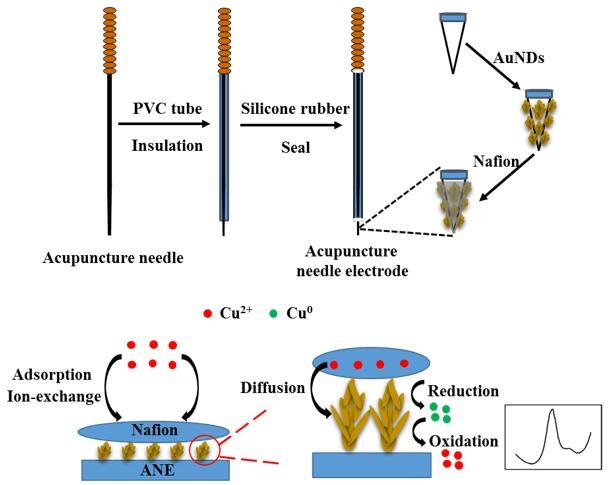Trace heavy metals in seawater are important harmful pollutants to human health and ecological environment. The toxicity of heavy metals is closely related to their existing forms in seawater environment, not their total concentration. As the specification for marine monitoring of China (GB 17378-2007) and American EPA standard method for heavy metal detection, anodic stripping voltammetry (ASV) is the most simple and effect technique for the speciation analysis of metal elements. In view of the limitation of sensitivity of sensors, it is of great significance to fabricate novel sensors with high sensitivity for speciation analysis of trace active heavy metals in seawater. Inspired by the traditional Chinese treatment method of acupuncture, the "Monitoring of Nutrient Elements in Coastal Zone and Application" group of Yantai Institute of Coastal Zone Research (YIC), Chinese Academy of Sciences (CAS) has prepared a new needle-shaped sensor based on the acupuncture stainless steel needle, through the processes of insulation, sealing and functionalization. The active heavy metals (copper as template) in seawater were successfully determined by the needle sensor. Thanks to the special morphology, size of needle electrode and the electrochemical catalysis and enrichment performance of functional nanomaterials, the needle sensor exhibits excellent performance and ultra-high sensitivity (detection limit 15.4 pM) for the detection of Cu by ASV. Through different sample pretreatment processes, the determination of three different forms of Cu (dissolved active, dissolved acid extractable and total acid extractable) in seawater was realized by using the needle sensor with ASV. After, as an improved construction method of needle sensor, self-assembly method was used to modify the surface of acupuncture needle with functional nanomaterials, which made the sensor more stable. The novel needle sensor based on stainless steel acupuncture needle shows advantages of high hardness, puncture ability and easy integration of sensors.
The relevant research results were published on the journals of Electrohimica Acta and Anlytic Methods, respectively. The above research works were funded by the Youth Innovation Promotion Association of CAS, the Key Research and Development Plan of Shandong Province and Yantai City.
Papers link:
1. https://www.sciencedirect.com/science/article/pii/S0013468618319170
2. https://pubs.rsc.org/en/Content/ArticleLanding/2019/AY/C9AY00222G#!divAbstract

Fabrication of the needle sensor and detection mechanism for Cu by ASV

Speciation analysis of Cu in seawater